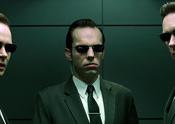"The Matrix" (1999) follows the events surrounding Neo (a.k.a Thomas Anderson) a computer hacker that is trying to find the answer to the question 'what is the Matrix?' This search leads him to Morpheus, a leader of a crew of rebels who are in search for the One, the person who will destroy the machines that are controlling the humans, therefore obliterating the Matrix and saving humankind. Neo finds that the Matrix is a computer program that controls the minds of humans in order for machines to feed of their battery life. He then joins Morpheus in his crusade to destroy the Matrix, and in doing so; he finds that he is indeed The One.
"The Matrix" is a story of how reality can be distorted, the difference between humans and machines, and the idea of a savior for humankind. While the film does have many elements typical of the action and science fiction genre, with the hero (Neo), the villain (Agent Smith), the teacher, or guiding hand (Morpheus), the love interest (Trinity), and the classic good versus evil conflict, The Matrix also delves into some very interesting and complex issues, and uses a lot of symbolism that leads to philosophical analysis.
Firstly, there is the issue of the man and the machine. When can a machine be classed as a person, and does free will and free thinking constitute a human being While the war is supposed to be man trying to destroy the machines, and machines trying to obliterate humans, both have qualities of each other, therefore blurring the line between to two sides. Firstly, Morpheus follows Neo almost as if he is programmed to, not questioning Neo, his identity, or his authenticity in regards to him being the One. Also, with the exception of Cypher,


